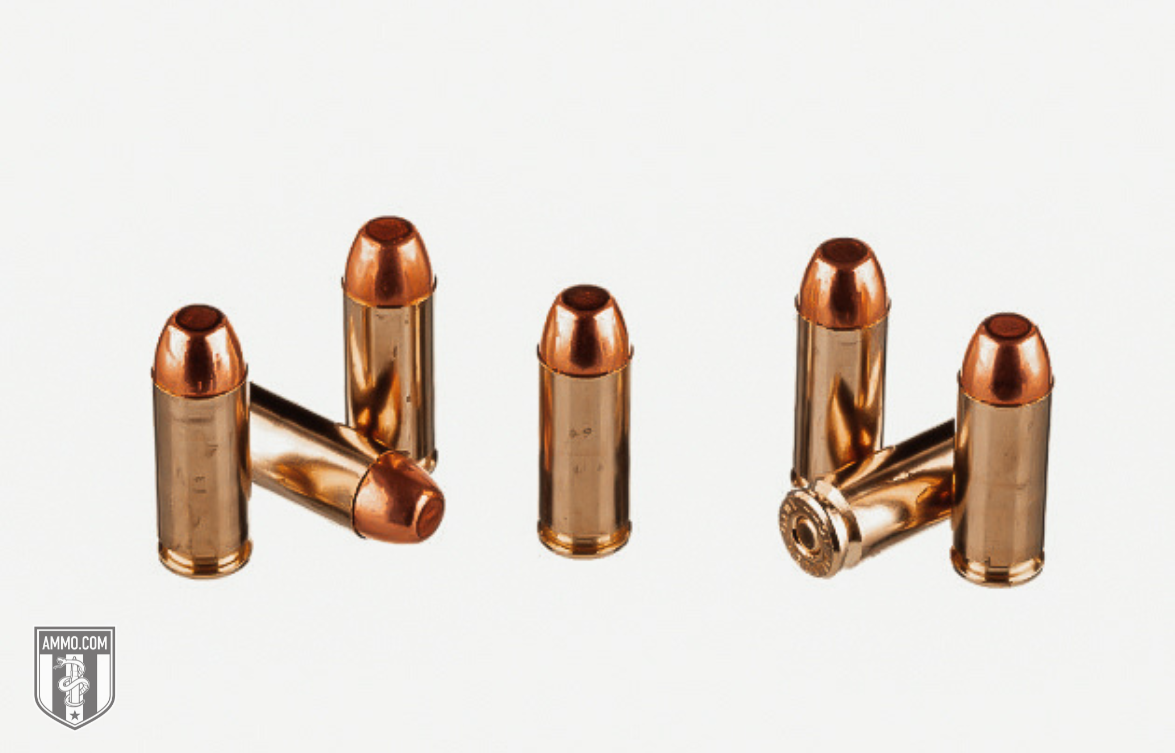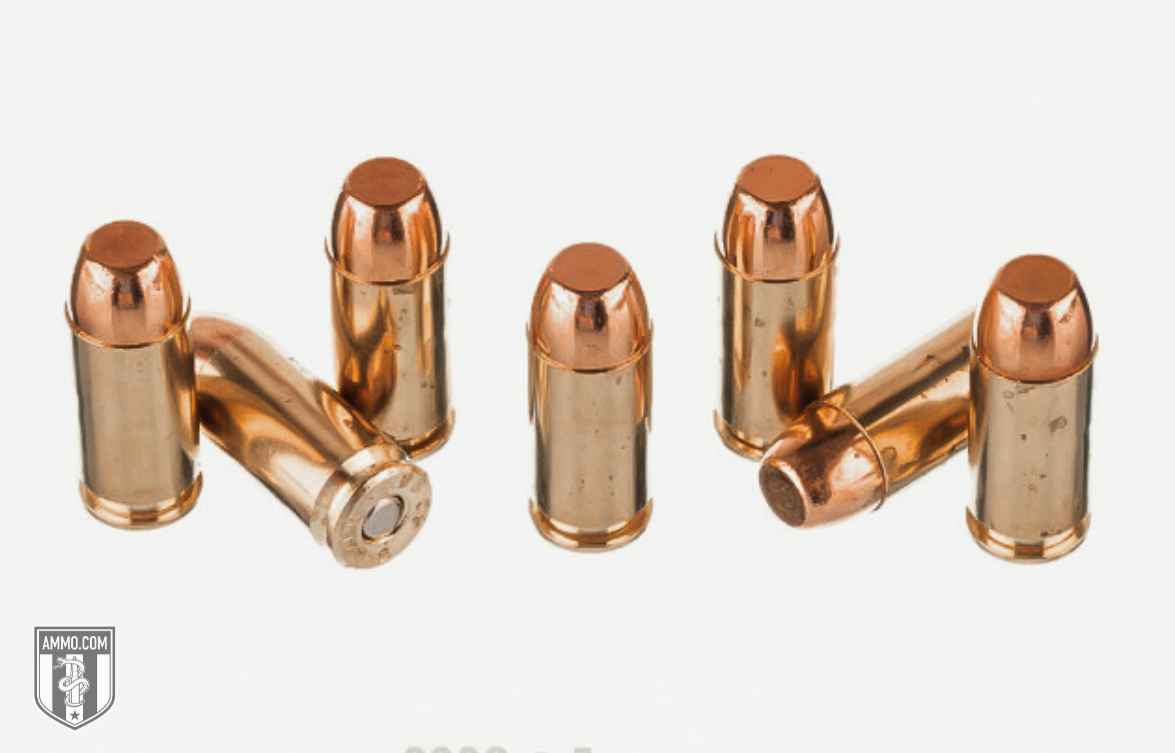10mm vs. 40 S&W: Which Cartridge Is Better?
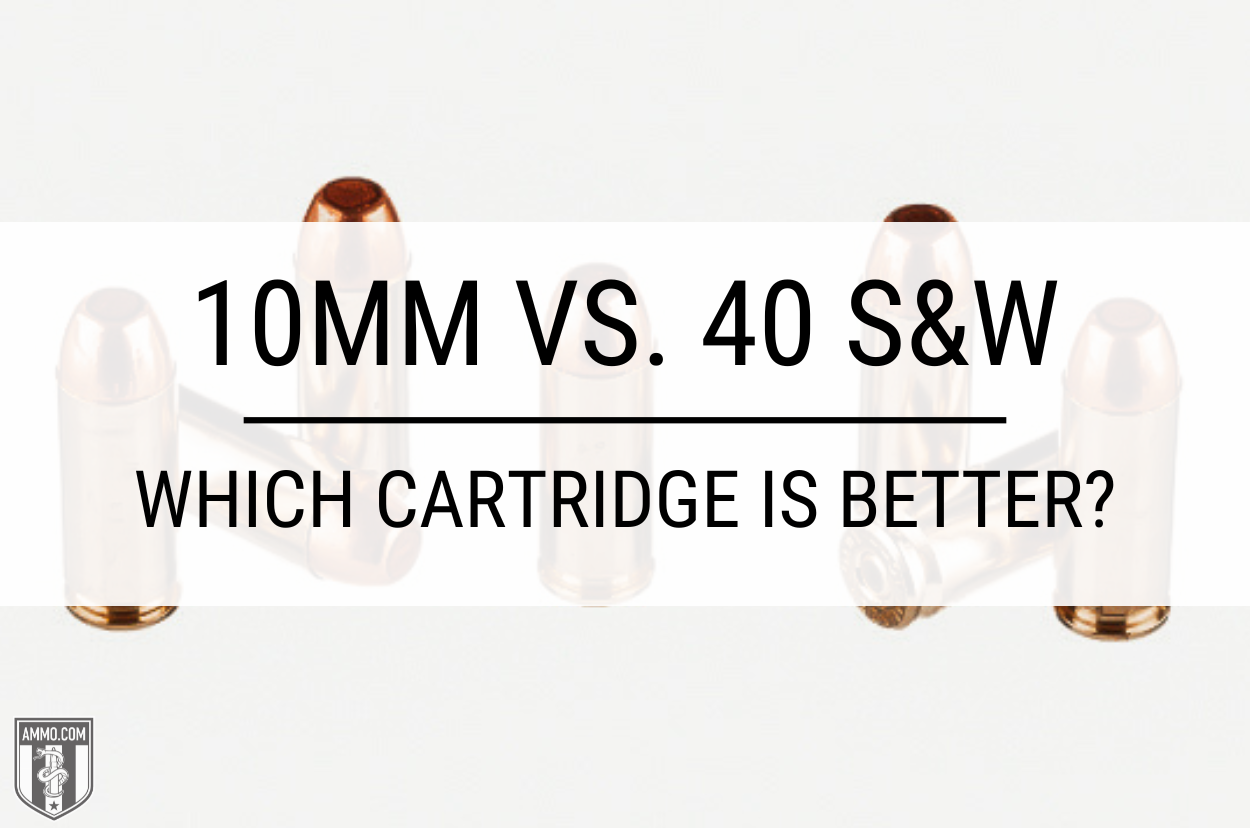 When we compare the two cartridges on paper, the 10mm should blow the 40 S&W out of the water. Lt. Col. Jeff Cooper designed the 10mm to exhibit better external ballistics than the 45 ACP, and the 40 Smith & Wesson was intentionally designed by weakening the 10mm.
When we compare the two cartridges on paper, the 10mm should blow the 40 S&W out of the water. Lt. Col. Jeff Cooper designed the 10mm to exhibit better external ballistics than the 45 ACP, and the 40 Smith & Wesson was intentionally designed by weakening the 10mm.
But there might be better choices than the 10mm for you for various reasons. We’ll compare these two cartridges based on their recoil, trajectory, accuracy, stopping power, effectiveness in self-defense, cost and availability, and reloading potential.
Continue reading to discover if the 10mm Auto is supreme – or if you should use a 40 Smith & Wesson instead!
10mm vs. 40
The 10mm was created to exhibit better terminal ballistics (i.e. penetration and expansion) than the 9mm Luger, as well as better external ballistics (i.e. effective range and muzzle velocity) than the 45 Automatic Colt Pistol.
The 40 S&W is a reduced power load based on the 10mm. It was developed in 1990 by Smith & Wesson and Winchester as a rimless, centerfire handgun cartridge to meet the FBI’s requirements for an effective defense round.
How do these two cartridges compare? Let’s begin with their specs.
Cartridge Specs
Since the 40 S&W was developed from the 10mm Auto, we should expect many similarities and a few significant differences in terms of the cartridges' specifications.
These two rounds’ bullet diameter, neck diameter, and base diameter are virtually identical to the naked eye (the 40 S&W base diameter is 0.001” narrower than the 10mm, and the neck diameter of the 40 is 0.009” narrower than the 10mm).
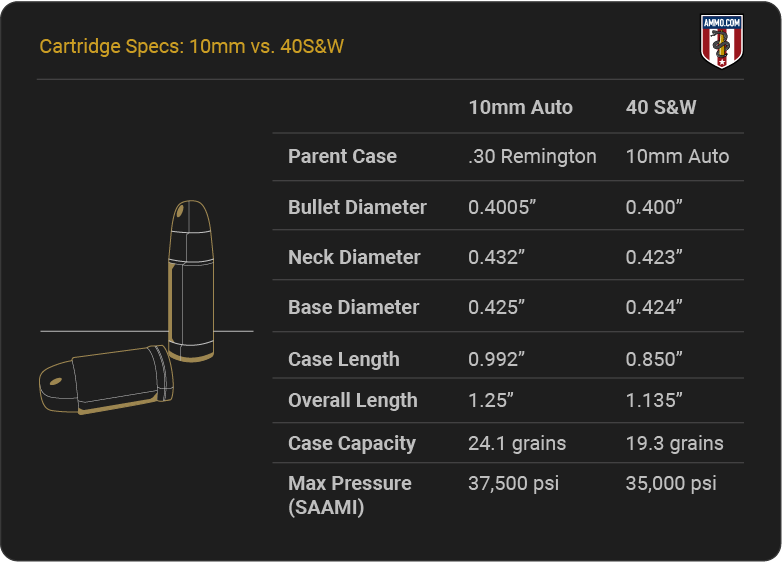
The .40 cal’s shorter case also means it is slightly shorter overall and has a lower case capacity than the 10mm, leading to a lower maximum pressure.
While these two rounds are visually distinct, they can be easily confused at the range. If you’re firing both cartridges during the same range day, keep them separate to prevent a catastrophe.
Let’s see how the visual differences equate to real-world performance.
Recoil
Bullet weight, firearm weight, muzzle velocity, and propellant weight determine how much recoil a cartridge generates. There is never an apples-to-apples comparison between any cartridge or caliber. That said, we can provide a general idea of how much felt recoil to expect while firing these rounds.
The average 10mm Auto 180 grain load has around 11.5 ft-lbs (foot-lbs) of recoil. To rifle shooters, this doesn’t sound like much, but that’s 50% more recoil than the 45 Auto( another comparable handgun cartridge).
The average 40 S&W 180 grain load has a little over 5.1 ft-lbs of recoil. In other words, the .40 S&W generally has less than half of the amount of recoil of the 10mm.
While some shooters do consider it a little snappy, recoil-sensitive individuals should go with the 40 S&W over the 10mm.
The .40 Smith & Wesson takes an early lead because it has less recoil than the 10mm Auto, allowing for more accurate follow-up shots as it will have less muzzle flip, making it much easier to remain on target or quickly get back on target.
Trajectory
Since most self-defense situations happen within 25 yards, the trajectory doesn’t matter all that much, as both calibers will remain relatively flat shooting at that distance.
However, the 10mm is often used for handgun hunting. In this instance, you will likely need to fire over distances greater than 25 yards, which necessitates careful consideration of bullet drop.
The 10mm has the advantage, as it has a flatter trajectory than the 40 S&W, simply because it’s more powerful.
Accuracy
Determining the accuracy of a round is tricky because so many factors must be considered. The shooter’s capabilities, bullet type, firearm, and shooting conditions all play a significant role in determining the round’s accuracy.
To keep everything as equal as possible, recoil and trajectory are also factors in the equation and are the primary considerations for this article. It is much easier to be accurate with a low-recoil, flat-shooting round than a heavy-recoil, arching round.
This section is a draw since the 40 S&W has lower recoil, and the 10mm has a flatter trajectory. Recoil-sensitive shooters often find the 40 Smith and Wesson more accurate, while long-range (i.e. anything over 25 yards) shooters often find the 10mm more accurate.
Stopping Power
The 10mm is more powerful than the 40 S&W. In the simplest possible terms, it, therefore, has more stopping power. However, both cartridges can neutralize a threat quickly, especially with proper shot placement, which is always more important than the stopping power of a round.
Bullet design and propellant load are other considerations for stopping power. Jacketed hollow point (JHP) bullets will have greater stopping power than full metal jacket (FMJ) bullets because JHPs expand upon impact, creating a larger wound channel while penetrating deep enough to reach vital organs.
The 10mm easily wins this section because the 40 S&W was intentionally designed to be less powerful.
Self-Defense
The 40 S&W and 10mm Auto are both capable self-defense rounds. Full-size semi-auto pistols (like the Glock 20 10mm Auto pistol and the Glock 22 40 S&W pistol), often used for concealed carry, come standard with 10-15 round magazines while remaining reasonably compact.
While you must concern yourself with over-penetration when using either cartridge in a home defense situation, the 10mm will prove slightly more likely to over-penetrate simply because it’s more powerful than a 40 S&W round.
Two other considerations for self-defense are ammo availability and cost, as you must regularly train with your CCW to ensure your skills remain sharp. We will discuss those next (spoiler: the 40 S&W is typically less expensive and more readily available).
I’ll give the 40 S&W the slight edge because it has a lower recoil, making follow-up shots faster, more accurate, and less expensive to fire. The 40 Smith and Wesson regains the lead.
Ammo & Firearm Cost/Availability
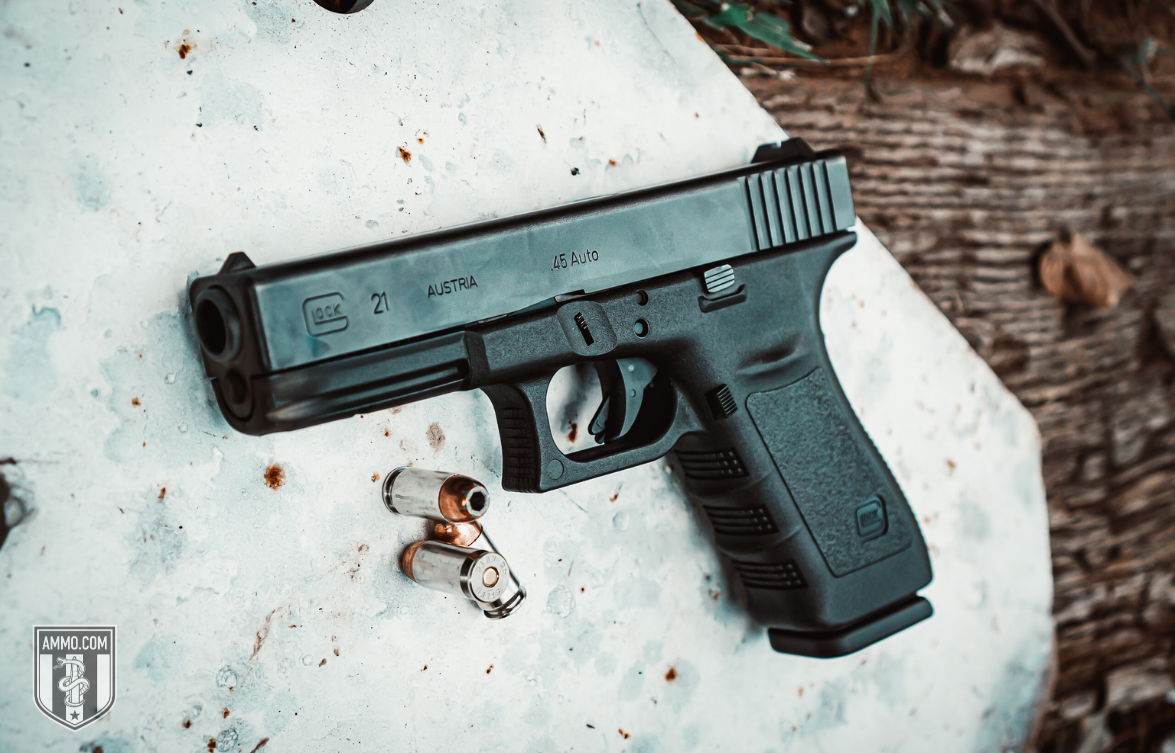
Generally, larger cartridges will cost more, which holds true for the 10mm and 40 S&W. The cost per round of 10mm Auto ammo is typically higher than 40 S&W of the same brand and bullet type.
The same is true for the cost of the firearms. A Glock 22, chambered in 40 S&W, is slightly less expensive than a Glock 20, chambered in 10mm.
It’s also often much easier to find 40 S&W firearms and ammo, whereas 10mm is less abundant but not especially hard to find (we carry a large assortment of 10mm rounds at Ammo.com).
Whether you’re looking to stock up on a bunch of ammo and guns or just looking for the cheapest option, the 40 S&W wins this section.
Reloading
Both cartridges can be reloaded. Abundant materials and information are available to craft handloads for the 10mm and 40 S&W alike. You can reload the spent casings with either cartridge you decide to purchase, so this section is a draw.
10mm vs. .40 S&W Ballistics
The 40 S&W is considered the “10mm lite” by many shooters. What does this mean regarding the ballistics of each cartridge? Let’s find out below!
10mm Ballistics
10mm Ballistics: Chart of Average 10mm Ballistics
Note: This information comes from the manufacturer and is for informational purposes only. The actual ballistics obtained with your firearm can vary considerably from the advertised ballistics. Also, ballistics can vary from lot to lot with the same brand and type load.
| 10mm Bullet WEIGHT | Muzzle VELOCITY (fps) | Muzzle ENERGY (ft. lbs.) | Mid-Range TRAJECTORY (in.) | Barrel Length (in.) | |||||
|---|---|---|---|---|---|---|---|---|---|
| Muzzle | 50 yds. | 100 yds. | Muzzle | 50 yds. | 100 yds. | 50 yds. | 100 yds. | ||
| 155 Grain | 1125 | 1046 | 986 | 436 | 377 | 335 | 0.9 | 3.9 | 5" |
| 155 Grain | 1265 | 1118 | 1018 | 551 | 430 | 357 | n/a | n/a | 5" |
| 170 Grain | 1340 | 1165 | 1145 | 680 | 510 | 415 | 0.7 | 3.2 | 5" |
| 175 Grain | 1290 | 1140 | 1035 | 650 | 505 | 420 | 0.7 | 3.3 | 5.5" |
| 180 Grain FBI | 950 | 905 | 865 | 361 | 327 | 299 | 1.5 | 5.4 | 4" |
| 180 Grain | 1030 | 970 | 920 | 425 | 375 | 340 | 1.1 | 4.7 | 5" |
| 180 Grain HV | 1240 | 1124 | 1037 | 618 | 504 | 430 | 0.8 | 3.4 | 5" |
| 200 Grain | 1160 | 1070 | 1010 | 495 | 510 | 430 | 0.9 | 3.8 | 5" |
For more detailed information, check out our 10mm ballistics page.
.40 S&W Ballistics
| Use Case | Details |
|---|---|
| Best .40 S&W Ammo | Best Overall: Hornady Critical Defense 165gr Runner Up: Winchester USA Ready Defense 170gr |
| Best .40 S&W Ammo for Self-Defense | Best Overall: Speer Gold Dot 165 gr JHP Runner Up: Winchester PDX1 Defender 165 gr JHP |
You can also check out our in-depth look at 40 Cal ballistics from all of the popular ammo manufacturers if you're in search of ballistics data for your favorite factory load.
10mm Brief History
Jeff Cooper, Whit Collins and Irving Stone developed the 10 mm Auto in the 1980s. Dornaus & Dixon Enterprises, Inc. and Norma manufactured the Bren Ten 10mm Auto (based on the CZ-75). However, the Bren Ten had several issues (despite being a hit with Don Johnson preferred in Miami Vice). Colt essentially saved the 10mm when it created the 1911 Delta Elite chambered in 10mm.
Even with the development of the Delta Elite, the 10mm wasn’t gaining popularity with law enforcement or civilians until a shootout in Miami between FBI agents and bank robbers in 1986. After making the 10mm a standard-issued cartridge, the FBI soon realized that the 10mm had too much recoil for many law enforcement officers, giving way to the .40 S&W.
Today, the 10mm is primarily used for self-defense and handgun hunting. It is much less popular than the 357 Magnum, 45 ACP, and 9mm. It sits in a niche segment, much like the 357 SIG. Springfield Armory, Glock, Ruger, and several other manufacturers manufacture 10mm pistols. Buffalo Bore, Hornady, Federal, Underwood, Winchester, and many other reputable ammo makers offer 10mm ammo.
.40 S&W Brief History
The 40 Smith & Wesson was introduced in 1990 as a collaboration between Smith & Wesson, Winchester, and the FBI (to an extent). A standard 40 S&W full metal jacket (FMJ) 165 grain bullet exits the muzzle at a velocity of 1,130 fps and with a muzzle energy of 468 foot-pounds – notably not as much as the 10mm.
Despite being less powerful than its hard-kicking relative, the 40 S&W became incredibly popular with American law enforcement and concealed carry permit holders.
Today, the 9mm has surpassed the 40 S&W’s popularity (largely thanks to bullet technology advancements). Some still appreciate the 40's high magazine capacity, solid stopping power, and reduced recoil (compared to the 10mm, at least).
Parting Shots: 10mm vs. 40 S&W
Now that we’ve finished comparing and contrasting the 10mm vs. 40 S&W, it’s time to tally up the scores and determine the winner.
Drum roll, please!
The 10mm won two sections (trajectory and stopping power), while the 40 S&W won three sections (recoil, self-defense, cost/availability). Two sections (accuracy and reloadability) were a draw.
It’s up to you to determine which areas hold more weight for your situation, but I’ll typically lean toward the 40 S&W in most instances.
Ammo Comparisons
- .308 vs 5.56
- 6.5 Creedmoor vs .308
- .300 Blackout vs .308
- .300 Win Mag vs .308
- .243 vs .308
- .308 vs .30-06
- 7mm-08 vs .308
- .270 vs .308
- 7.62x39 vs .308
- .223 vs .308
- .338 Lapua vs .308
- .380 ACP vs 9mm
- .223 vs 5.56
- .300 Blackout vs 5.56
- 9mm vs 45 ACP
- 9mm vs 40 S&W
- .357 SIG vs 9mm
- 10mm vs 9mm
- 9mm vs 9mm Luger
- .243 vs .270
- .300 Win Mag vs .30-06
- .270 vs .30-06
- .40 vs .45
- 38 Special vs 357
- 9mm vs 40 vs 45
- 5.56 vs 7.62x39
- 338 Lapua vs .30-06
- .30-30 vs .30-06
- 300 PRC vs 338 Lapua
- .30-06 vs 7mm
- 300 Win Mag vs 338 Lapua
- 300 PRC vs 300 Win Mag
- 300 WSM vs 300 Win Mag
- 338 Win Mag vs 338 Lapua
- 12 Gauge vs 20 Gauge
- 10mm vs 357 Mag
- .30-30 vs 7.62x39
- 224 Valkyrie vs 22-250
- 17 HMR vs 22 Mag
- 7.62x39 vs .300 Blackout
- 45 ACP vs 45 Auto
- 45-70 vs 30-30
- 300 Blackout vs 223
- 357 Magnum vs 9mm
- 350 Legend vs 300 Blackout
- 224 Valkyrie vs 223
- 45 ACP vs 38 Super
- 6.5 Grendel vs .308
- 17 HMR vs 22 LR
- 10 Gauge vs 12 Gauge
- 22-250 vs 223
- 45 Colt vs 45 ACP
- 350 Legend vs 30-30
- 5.7x28 vs 223
- 5.7 vs 9mm
- 5.56 vs 5.7
- 22 vs 9mm
- Buckshot vs Birdshot
- 450 Bushmaster vs 308
- 450 Bushmaster vs 223
- Buckshot vs Slug
- 6.5 Grendel vs 5.56 vs 223
- 6mm ARC vs 6.5 Grendel
- 44 vs 45
- 458 SOCOM vs 5.56
- 357 vs 44
- 32 ACP vs 380
- 300 Win Mag vs 338 Win Mag vs 338 Lapua Mag
- 450 Bushmaster vs 458 SOCOM vs 50 Beowulf
- 6mm Creedmoor vs 6.5 Creedmoor
- TMJ vs FMJ
- 44 Special Vs 44 Magnum
- 45 90 vs 45 70
- 6.8 Western vs 6.8 SPC
- 50 Beowulf vs 50 BMG
- 26 Nosler vs 6.5 PRC
- 28 Gauge vs 410
- 6.8 SPC vs 5.56
- 6.8 SPC vs 6.5 Grendel
- 6.8 Western vs 7mm Rem Mag vs .28 Nosler
- 6.8 Western vs 6.5 Creedmoor
- 22 Hornet vs 223
- 6.8 Western vs 6.5 PRC
- .410 vs 12 Gauge
- .410 vs 20 Gauge
- 22 LR vs 22 Mag
- 6mm ARC vs 243
- 7mm-08 vs 270
- 243 vs 6.5 Creedmoor
- Nickel vs Brass Casing
- 204 Ruger vs 223
- 50 Beowulf vs 5.56
- 260 Remington vs 6.5 Creedmoor
- 6mm Remington vs 243
- 28 Nosler vs 300 PRC
- 50 Beowulf vs 50 AE
- 22 Nosler vs 22-250
- 450 Marlin vs 45-70
- 300 Win Mag vs 300 Norma
- 458 SOCOM vs 300 Blackout
- 38-55 vs 45-70
- 22 Hornet vs 22 LR
- 300 Norma vs 338 Lapua
- 338 Lapua vs 50 BMG
- 28 Nosler vs 300 Win Mag
- 28 Nosler vs 6.5 Creedmoor
- 204 vs 22-250
- 458 SOCOM vs 45 70
- 44 40 vs 45 70
- 6.8 SPC vs 6.5 Creedmoor
- 450 Bushmaster vs 30-06
- 7mm Rem Mag vs 300 Win Mag
- 30 Carbine vs 223
- 25-06 vs 30-06
- 26 Nosler vs 28 Nosler
- 16ga vs 12ga
- 30 06 vs 7.62 x54R
- 9mm Makarov vs 9mm Luger
- 350 Legend vs 223
- 30 Carbine vs 5.56
- 6.5x55 vs 6.5 Creedmoor
- 6.5 Creedmoor vs 270 vs 25-06
- M193 vs M855
- 450 Bushmaster vs 458 SOCOM
- 6.5 Grendel vs 6.5 Creedmoor
- 350 Legend vs 5.56
- .277 Fury vs 6.8 SPC
- 277 Fury vs 300 Win Mag
- 10mm vs .45 ACP
- 277 Fury vs 223
- 6.8 SPC vs 300 Blackout
- 6.5 PRC vs 6.5 Creedmoor
- 277 Fury vs 308
- 277 Fury vs 6.5 Creedmoor
- 350 Legend vs 450 Bushmaster
- 277 Fury Vs 5.56 NATO
- 10mm vs 40S&W
- 32 ACP vs 9mm
- 32 Special vs 9mm
- 8.6 Blackout vs 300 Blackout
- 30 Super Carry vs. 9mm
- 5.56 vs 9mm
- .50 Action Express vs 9mm
- 7.62x25 vs. 9mm
- 10mm vs 44 Magnum
- 300 Blackout vs 300 Win Mag
- 6.5 Grendel vs 300 Blackout
- 460 Rowland vs 10mm
- 300 RUM vs 300 PRC
- 300 Norma vs 300 PRC
- 45 GAP vs 45 ACP
- 7mm PRC vs 300 Win Mag
- 300 PRC vs 6.5 Creedmoor
- 300 PRC vs 308
- 357 SIG vs 357 Mag
- 7.62x39 vs 7.62x51
- 243 Win vs 223 Rem
- 30 Nosler vs 300 PRC
- 6.5 Creedmoor vs. 30-06 Springfield
- 450 S&W vs. 44 Magnum
- 6.5 Creedmoor vs. 300 Win Mag
- 454 Cassull vs. 45-70 Govt
- 454 Cassull vs. 44 Mag
- 7.62x54r vs. 308 Winchester
- 22 ARC vs. 223 Rem
- Subsonic vs. Supersonic Ammo
